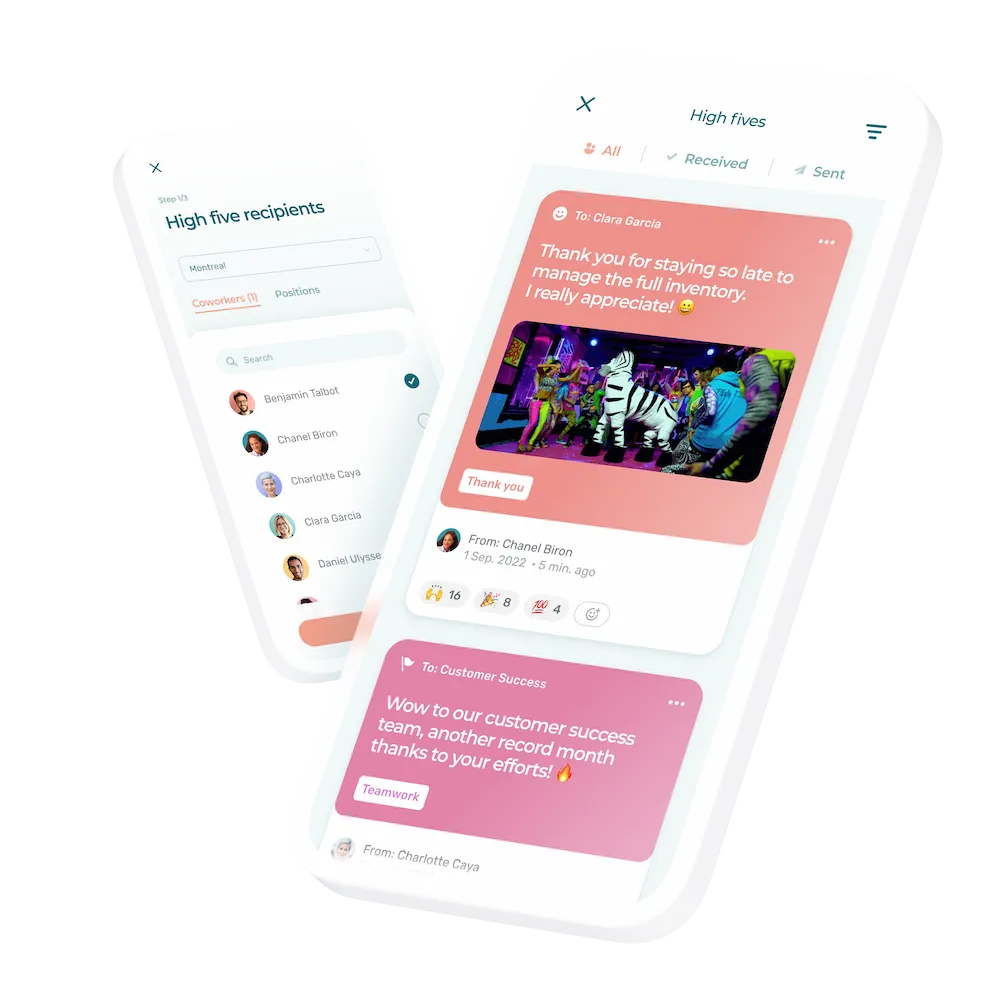Retail Employee Management: What it is and How to Effectively Motivate Workers
In retail, there is a direct link between the employee experience and the customer experience.
Happy and engaged employees lead to happy and loyal customers. This article offers brick and mortar retailers tips on how to improve retail employee management to improve employee motivation and business performance.
What Is Employee Engagement in Retail?
Employee engagement in retail is the emotional commitment retail employees have to the organization. Engaged employees are more willing to go the extra mile to provide a positive customer experience. Organizations can increase retail employee engagement and business performance by focusing on key employee motivators.
Why Is Employee Engagement Important in the Retail Industry?
The struggling retail industry needs employee engagement more than ever. Why? 96% of consumers say customer service influences their choice of brand.
For retail managers, a key priority for 2023 should be keeping your retail teams happy.
According to the Harvard Business Review, customer-facing employees and revenue are strongly linked.
Retail businesses that create an employee experience that keeps employees engaged and motivated benefit in numerous ways:
1. Higher Customer Satisfaction
Industry research shows a link between retail employee engagement and customer satisfaction. When retail leaders raise employee engagement levels, they gain a competitive advantage.
2. Lower Employee Turnover
Engaged employees are less likely to voluntarily quit their job. In the retail sector, relatively high employee turnover is normal, but it’s also costly.
Typical Cost of Replacing Retail Workers
- 16% of annual salary to replace an associate-level worker. If a sales associate makes $10 an hour, it will cost around $3,328 to replace them.
- 20% of annual salary to replace a mid-range position, such as a manager. If a store manager earns $40,000 a year, it will cost around $8,000 to replace them.
Even more worrisome is the fact that employee turnover in retail has skyrocketed in recent years. An excessively high turnover rate crushes staff morale and productivity. It also results in poor customer service.
3. Reduced Employee Stress
Unengaged employees tend to be more stressed. The American Institute of Stress reports that stress costs American businesses $300 billion a year—a cost that store and regional managers cannot and should not ignore.
4. Less Employee Burnout
When left unchecked, employee stress and low engagement create a vicious cycle that can quickly lead to employee burnout in retail. According to McKinsey & Company, 49% of workers reported at least some level of burnout in April 2021.
5. Increased Employee Productivity
Engaged employees are 17% more productive, according to Gallup. This can directly boost the retail business’s profitability and reputation.
6. Stronger Employee Commitment
Engaged employees are committed to the organization’s success. They’re more likely to devote time and effort to value-added tasks outside their normal job description, such as proposing ideas to improve work methods and training new employees.
7. Better Employee Collaboration
Employees who feel connected to their company and the entire team are more likely to collaborate effectively with colleagues. This promotes engagement among their peers, creating a positive cycle.
8. Lower Employee Absenteeism
Engaged employees report 81% lower absenteeism than companies with low engagement. A recent retail survey found that roughly 13% of labor hours go to waste due to absenteeism and poor scheduling practices.
9. Fewer Accidents, Safer Workplaces
Workplace accidents represent a huge risk for organizations. Companies with the highest retail employee engagement rates report 70% fewer accidents than those with the lowest rates. Engaged employees are more attentive at work, more likely to speak up about concerns, and less likely to take risks.
10. Higher Sales
Engaged employees are more likely to build strong customer relationships, which research shows translates to 20% higher sales. That’s a make-or-break figure for any retail chain.
11. Higher Revenue
Combine the 10 above sales-boosting and cost-cutting benefits, and what you get is a clear path to increasing revenues in retail. Gallup found that highly engaged companies are 21% more profitable than less-engaged competitors.
Create a great employee experience that keeps employees engaged and productive.
Low Employee Engagement in Retail: 3 Main Reasons
Customer experience is key in retail. A whopping 89% of companies expect to compete primarily on customer experience.
And yet, only 36% of employees in the U.S. say they are engaged in their work, yikes!
That’s a disconnect that can lead to retail failure. CEOs in retail should be taking close note.
Here are the 3 most common reasons for poor engagement in retail.
1. Disorganized and Uncontrollable Work Schedules
Poor retail employee scheduling can wreak havoc in retail. Not only for business productivity and performance, but for job satisfaction as well.
Communicating work schedules, shift swaps, and last-minute scheduling changes can be a serious time drainer for store managers.
Never knowing if your work schedule is going to suddenly change can also crush employee motivation.
Following best practices for retail schedules can eliminate many of these issues.
2. Stress and Burnout
Retail work can be stressful and fast-paced at times. Particularly during busy seasonal periods.
Throw in a chronic labor shortage, relatively low pay, the volatility exacerbated by the COVD pandemic and it’s no surprise that burnout in retail has become a huge problem.
The Global Report of Frontline Workers cites burnout as the top reason for retail workers quitting (58%).
3. Isolation and Alienation
Retail shift workers don’t always get a lot of face-to-face time with their supervisors. Or with their associates working at other physical locations.
This can lead to a lack of clarity, direction and poor sense of belonging.
Having an internal messaging platform will connect employees with each other and with their manager. This will keep store associates informed, and happily collaborating effectively.
7 Best Practices to Motivate Employees
Retail businesses that create a strategy to improve the overall employee experience will better engage retail employees.
The following 7 best practices include the key employee motivators.
1. Invest in the Employee Experience
Companies that invest in the employee experience are four times more profitable than those that don’t. It’s good for attracting and retaining retail workers, and good for your bottom line.
2. Empower Communication
Open and regular communication is the key to engaged employees. Even more so if team members don’t always work the same shifts.
Good communication will ensure everyone is kept in the loop and foster a sense of team spirit and belonging.
- Give employees an easy way to communicate with their direct supervisor and coworkers.
- Use a company instant messaging platform to centralize and facilitate communication between teams.
- Make open communication part of the corporate culture and demonstrate this from day-one of the employee onboarding process.
3. Make Communications Mobile-Friendly
Many retail employees work in-store, on their feet. Most are carrying around a mobile device. Using email and desktop apps as your primary mode of internal retail communications makes little sense.
Let mobile technology improve retail employee engagement the easy way.
- Adopt an employee scheduling software that comes with a mobile app. It will make it easier for retail employees to stay up to date on work schedules and company news. Some software even offer more advanced options that centralize employee profiles, allow staff to share recognition with peers and employee surveying. It will also make managing employee absences easy for store managers.
4. Recognize and Reward Employees
Being a retail worker can be a thankless job at times. Store employees are constantly confronted with hard-to-please customers, volatile work schedules, and busy seasonal periods.
Over time, employee motivation can suffer.
Store managers need to ensure that employees who go above and beyond feel appreciated and valued. A little employee recognition can improve employee engagement in a big way.
- Build motivation by naming an employee of the month.
- Use an employee recognition tool that lets you send out high fives to staff. It’s a quick and easy way to tell employees their hard work is noticed and appreciated.
- Let employees give high fives to other store associates as well—such as when a coworker covers a shift last minute.
- Boost team morale by rewarding employees with monetary rewards if your budget allows for it.
5. Encourage Employee Feedback and Put It to Use
Frontline employees have first-hand knowledge of consumer wants and needs. For the retail sector, putting this knowledge to productive use is simply good business.
- Regularly conduct pulse surveys to obtain continuous feedback and actionable data that can help your retail stores achieve the company’s goals.
- Conduct annual employee surveys to do a deep dive into the employee experience.
6. Support Store Managers and Ease Their Burden
Store managers often set the tone for customer-facing employers. But it’s not an easy job. They, too, can feel undervalued.
Store managers have to keep both front-line staff and upper management happy, all while juggling recurring tasks like recruiting and hiring, employee scheduling and payroll, overseeing day-to-day store activities, hitting sales and other targets, etc.
- Help store managers feel supported by giving them tools that will ease time consuming administrative tasks. A great employee management tool will free them to focus on more value building tasks. Sales improve when a retail manager can regularly provide feedback to staff and help them develop new skills.
7. Encourage Social Relationships
Social relationships are a huge driver of employee engagement. Over a third of employees look forward to going to work when they have a workplace friend.
- Use your company instant messaging platform to promote open communication. It’s a great way to encourage employees to communicate, plan social events and discuss mutual interests.
- Encourage in-person interactions. Give employees a nice break room. Plan social outings with the entire team, particularly when new hires come on board.
3 Companies That Have Nailed Employee Engagement
Arby’s
When times get tough, Arby’s turns to the insider knowledge of frontline employees for ideas on how to turn things around. This gives corporate decision makers clearer perspectives on both the customer and employee experience.
It also empowers frontline workers, who know that upper management values their insights and cares about employee happiness.
Best Buy
Best Buy has long boasted strong in-store experiences and strong employee engagement. Frontline staff are encouraged to use their own judgment when it comes to providing great customer service—rather than given a list of instructions to follow.
This trust from the top empowers customer-facing staff and has led to high employee morale, along a great customer experience.
Sephora
Sephora’s great employee experience is built on three cornerstones:
- Training. All frontline staff (called “cast members”) receive thorough training from day one, and are continually retrained on new products.
- Technology. Frontline staff get to work with cutting-edge technology such as handheld registers, which make their jobs easier and more enjoyable.
- Development. The company embraces internal development and employee mobility between positions, stores, departments, and even countries. Frontline and corporate team members alike can speed up their professional development at one of the three Sephora University physical locations worldwide.
Conclusion
Retaining staff has always been a challenge in the retail industry.
Improving the employee experience is an easy way for retail stores to increase employee engagement—and improve your bottom line in the process. It’s a win for customers, store employees and your business.
Looking for your own professional workspace that gives retail staff access to one-on-ones, group conversations, business-wide updates, automated notifications and more—all in one handy centralized location?
See what Agendrix software can do for your retail business!
How Can Retailers Improve Employee Engagement?
Employee engagement can be improved in 3 key ways.
- By improving the employee experience to increase job satisfaction and motivation.
- By improving employee retention. Having a good retail onboarding program can increase retention of frontline staff.
- By empowering employees with the information they need to do their job with ease. Employee management software for retail facilitates internal communication and gives frontline staff more control over their work hours.
Why Is Employee Engagement Important in Retail?
Frontline employees are the face of the business. Most employees interact with customers daily and have in-depth knowledge of customer needs and expectations.
They are also the ones who carry out the customer-facing component of the retailer’s business strategy. If employee engagement is poor, so will the execution of this strategy.
How Do You Measure Employee Engagement in Retail?
The engagement level of retail employees can be measured in a number of ways:
- By tracking changes in employee retention, turnover and absenteeism rates
- By tracking metrics such as internal promotions and employment duration
- By distributing pulse surveys to collect feedback on specific aspects of employee engagement
- By collecting feedback from store managers on employee motivation and productivity levels
- By monitoring internal employee communications
- By creating a way for retail employees to freely share feedback on their employee experience and ideas for improving it










